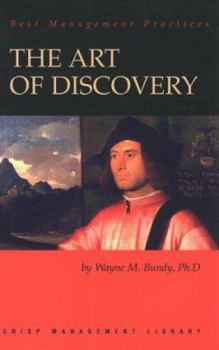The Art of Discovery
The word creativity is approaching the status of "buzzword," but this book will show how to take the word seriously and make discovery an instrument of change in any organization. This description may be from another edition of this product.
Format:Paperback
Language:English
ISBN:1560524383
ISBN13:9781560524380
Release Date:June 1997
Publisher:Crisp Learning
Length:75 Pages
Weight:0.35 lbs.
Dimensions:0.3" x 5.4" x 8.4"
Customer Reviews
1 rating
A good book to read. If you are a R & D engineer, GO FOR IT!
Published by Thriftbooks.com User , 18 years ago
THE ART OF DISCOVERY: FUELING INNOVATION FOR COMPANY GROWTH by Wayne Bundy For a relatively concise format, with only 70 odd pages, this wonderful book is packed with fresh insights as well as valuable practical guidelines for the pursuit of creativity & innovation within an industrial & /or technological landscape. It offers a more holistic model for creative discovery, with a dynamic balance of aesthetics, scientifc method & serendipity. This model adds two stages to the classic model: knowledge gain piror to preparation, & stimulation coactive with incubation, as illustrated below: - Knowledge gain; - Preparation; - Incubation; - Stimulation; - Illumination; - Verification & Commercialisation; The author contends that creativity will not happen without knowledge gain, which is the first stage in the model. This model resonates relatively well with the Japanese model envisaged by Dr Yoshiro Nakamatsu, or Dr NakaMats as he is better known, the world 's most prolific inventor with 3,280 inventions to his credit. He invented the floppy disk (for which a licence was sold to IBM), compact disk & digital watch. He calls it the Five Tier Pagoda Approach to Inventions (The author readily admits that the Japanese are geniuses in making incremental advances, & they make great improvements in profitability by this means.): from the top: - Leap of the Mind; - Experience; - Knowledge; - Mind Body/Connection; - Spirit; According to Dr NakaMats, the most critical stages are the top three, & of those stages the fifth could not exist without the third & fourth stages. In other words, one must have a broad exposure to knowledge & experience before attempting creative solutions & applications. He argues that his process of invention depends on two basic skills: - applying the requisite knowledge to bring a product concept to the prototype stage where it can be tested for feasibility, practicality & marketability, & eventually patented; - understanding the needs of the users; The author of this book holds exactly the same line of thought. For stimulation co-active with incubation, the author provides three general kinds of mental actions that can help in the stimulation step of discovery: basic research, external stimuli & specialised thought processes. Obviously, the author's approach in this respect takes a more or less structured & conventional route. In contrast, Dr NakaMats takes a more radical approach to incubation & stimulation. He uses a planned sequence of provocative techniques, from spending time in a 'calm room', then, to a 'dynamic room' & finally, to 'underwater brainstorming'. However, this approach is definitely not suitable for the faint-hearted! Nevertheless, in this book, the author outlines the various modes of thinking that can lead to discovery, in the form of Chapter II from page 27 to 46. I like this particular chapter because of its broad coverage. On page 50 of the book, as part of Chapter II





